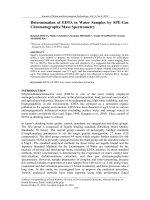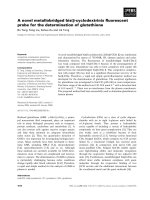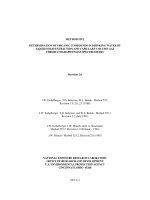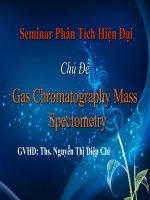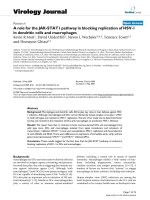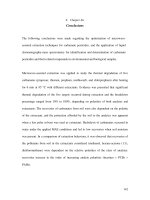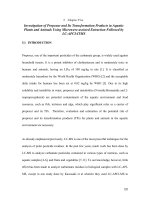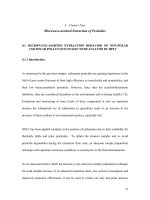Optimization of a gas chromatography–mass spectrometry method using chemometric techniques for the determination of ezetimibe in human plasma
Bạn đang xem bản rút gọn của tài liệu. Xem và tải ngay bản đầy đủ của tài liệu tại đây (1.67 MB, 12 trang )
Turkish Journal of Chemistry
/>
Research Article
Turk J Chem
(2013) 37: 734 – 745
ă ITAK
c TUB
doi:10.3906/kim-1210-18
Optimization of a gas chromatographymass spectrometry method using
chemometric techniques for the determination of ezetimibe in human plasma
ă
ă
Ebru UC
á AKTURK,
Nuran OZALTIN
Department of Analytical Chemistry, Faculty of Pharmacy, Hacettepe University, Ankara, Turkey
Received: 16.10.2012
•
Accepted: 18.03.2013
•
Published Online: 16.09.2013
•
Printed: 21.10.2013
Abstract: A new, rapid, and sensitive gas chromatography–mass spectrometry (GC-MS) method was developed for the
determination of ezetimibe (EZE) in human plasma. EZE was derivatized prior to GC-MS analysis. Various derivatization
techniques such as acetylation, methylation, and silylation were tried. EZE was extracted from plasma with high recovery
(94.39%–97.57%) using methyl tertbutyl ether and carbonate buffer (pH 9). Chromatographic conditions were optimized
using chemometric methods. In the first step, optimization with factorial design, chromatographic variables (initial and
final column temperature, oven ramp rate, and flow rate of gas) were screened to select important variables for the
retention of EZE. In the second step, central composite design was applied to decide on the retention time of EZE. The
analysis was achieved in a short period of time ( < 4 min). The developed method was validated for parameters including
specificity, limit of quantitation, linearity, accuracy, precision, recovery, stability, robustness, and ruggedness. The limit
of quantitation was found to be 10 ng mL −1 . The method was successfully applied to determine total EZE in the plasma
of hypercholesterolemic patients.
Key words: Ezetimibe, gas chromatography–mass spectrometry, human plasma, experimental design, validation
1. Introduction
Ezetimibe (EZE) is a synthetic and specific cholesterol absorption inhibitor. It inhibits the absorption of sterols
in the intestine by selectively binding to the intestinal cholesterol transporter, Niemann-Pick C1-Like 1. 1,2 After
oral administration, EZE is absorbed and extensively converted to EZE ketone, and EZE benzylic glucuronide,
minor metabolites, and also the pharmacologically active metabolite EZE-glucuronide by glucuronidation of its
4-hydroxyphenyl group. EZE and its glucuronide are major fragments in plasma. 3,4
Ezetimibe was approved in 2002 by the Food and Drug Administration (FDA). In 2008, the FDA reported
early communications about safety concerns regarding EZE, EZE/simvastatin, and simvastatin and urges both
healthcare professionals and patients to report side effects EZE. Studies about these safety issues are still being
evaluated. 5,6
Analytical methods for the analysis of EZE in biological samples are required to evaluate its safety
and efficiency, to understand its pharmacokinetic profile among various patients, and to determine therapeutic
concentration in patients.
In the literature, several analytical methods such as liquid chromatography tandem mass spectrometry
(LC/MS/MS), high performance liquid chromatography–ultraviolet detection (HPLC/UV), and GC-MS were
∗ Correspondence:
734
¨
¨
UC
¸ AKTURK
and OZALTIN/Turk
J Chem
reported for the analysis of free and total EZE and EZE-glucuronide in biological samples. 7−10 The reported GCMS method is time- consuming because of the long analysis time (about 15 min) and also recovery of EZE from
plasma is low. 10 In the proposed study, different derivatization techniques and derivatization reagents were tried.
Solid phase and liquid–liquid extraction were used for extraction of EZE from plasma. Chemometric methods
such as full factorial design and central composite design (CCD) were used to optimize the chromatographic
variables. After the developed method was fully validated, it was applied to determine total EZE in the plasma
of hypercholesterolemic patients.
2. Experimental
2.1. Chemicals and reagents
EZE and oxymetholone (internal standard (IS)) were obtained from Central Institute of Hygiene of Turkey and
the Turkish Doping Control Center (Ankara, Turkey), respectively. N -methyl-N -(trimethylsilyl)trifluoroacetamide (MSTFA), bis(trimethylsilyl)acetamide (BSA), trimethylchlorosilane (TMCS), N-methyl-N-trimethylsilylheptafluorobutyramide (MSHFBA), N-(tert-butyldimethylsilyl)-N-methyltrifluoroacetamide (MTBSTFA), Nmethyl-bis(trifluoroacetamide) (MBTFA), imidazole and β -glucuronidase from Helix pomatia (Type HP-2, =
100,000 units/mL of glucuronidase activity) were obtained from Sigma. β Mercaptoethanol, ammonium iodide
(NH 4 I), potassium carbonate, potassium bicarbonate, and methyl tertbutyl ether were purchased from Merck.
2.2. Instrumentation and GC-MS conditions
GC-MS analysis was performed on a 6890 N Agilent GC equipped with a 5973N mass selective detector. A
5% phenyl methylpolysiloxane capillary column (10 m × 0.25 mm id with 0.25 µ m film thickness, Agilent
Technologies, USA) was used for chromatographic separation. The initial temperature of the oven was set at
206 ◦ C; then the temperature was increased to 305 ◦ C at a rate of 33.11 ◦ C min −1 . The total run time for
an injection was 4 min. The mass selective detector was operated in electron impact ionization mode. Selected
ion monitoring (SIM) mode was used to determine EZE and IS. The ions of mass-to-charge ratio (m/z) 326 for
EZE and m/z 548 for IS were selected for quantitation. The electron multiplier of the MS detector was set to
306 eV. The temperatures of the front inlet, ion source and interface were 280, 230, and 280 ◦ C, respectively.
2.3. Preparation of standard solutions and validation samples
Stock solution of EZE (1000 µ g mL −1 ) was prepared by dissolving 10 mg of EZE in 10 mL of methanol.
Working solutions of EZE at concentrations of 10, 1, and 0.5 µ g mL −1 were used to prepare spiked plasma
samples. Working solutions were prepared by serial dilution of stock solution of EZE with methanol. Stock
solution was kept at − 20 ◦ C until use, while the working solutions were kept at 4 ◦ C.
In order to prepare spiked plasma samples for the validation study, an appropriate amount of working
standard solution of EZE and a constant amount of IS were added to 1.5 mL of plasma. The plasma samples
were made basic with 500 µ L of carbonate buffer (pH 9) and then EZE was extracted with 4 mL of ether.
The organic layer was evaporated to dryness under nitrogen. The residue was derivatizated with 40 µ L of
MSTFA/β -mercaptoethanol/NH 4 I .
735
¨
¨
UC
¸ AKTURK
and OZALTIN/Turk
J Chem
2.4. Preparation of derivatization reagents
MSTFA/β -mercaptoethanol/NH 4 I solution: For the stock solution, 100 mg of NH 4 I was added to 5 mL of
MSTFA. The mixture was vortexed and kept at 80 ◦ C until the ammonium iodide dissolved; then 300 µ L of
β -mercaptoethanol was added to it. Working solution was prepared by dilution of 556 µL of stock solution
with 5 mL of MSTFA.
MSTFA/Imidazole solution: 0.2 mg of imidazole was added to 5 mL of MSTFA and the mixture was
vortexed in order to dissolve imidazole.
BSA/TMCS, MSHFBA/TMCS, MTBSTFA/TMCS solutions: 0.1 mL of TMCS was added to 5 mL of
derivatization reagent.
All derivatization solutions were kept at +4 ◦ C in the dark.
2.5. Sample preparation for the analysis of real human plasma
The human blood samples were collected from patients approximately 1 h (t max ) after drug administration.
The blood samples were placed in a glass tube containing ethylenediaminetetraacetic acid as anticoagulant
and then centrifuged at 4000 rpm for 10 min. The supernatants (plasma) were transferred into test tubes. To
prepare plasma samples for analysis, firstly acidic hydrolysis was performed to convert EZE-glucuronide to EZE.
Hence, 10 µ L of IS, 500 µ L of sodium acetate buffer (0.5 M, pH 5) and 50 µ L of β -glucuronidase were added
to 1.5 mL of human plasma samples. They were incubated at 50 ◦ C for 60 min 4 The samples were extracted
and then derivatized with 40 µ L of MSTFA at 80 ◦ C for 60 min. The solution was injected into the GC-MS
system.
2.6. Method validation
The proposed method was validated according to FDA bioanalytical method validation guidelines 11 The
following validation parameters were evaluated: specificity, linearity, limit of quantitation, accuracy, precision,
stability, recovery, robustness, and ruggedness.
2.6.1. Specificity
Specificity was evaluated by analyzing 6 blank plasma samples obtained from different sources. Chromatograms
were investigated for any endogenous interferences at retention time of EZE and IS by monitoring the ions at
m/z 326, 416, and 463 for EZE and 548 for IS.
2.6.2. Linearity and limit of quantitation (LOQ)
In order to determine LOQ, spiked plasma samples having decreasing concentration of EZE were analyzed by
GC-MS and signal to noise ratio was calculated for each concentration. In addition, precision and accuracy
were calculated at LOQ level. 11
Linearity was performed by analyzing spiked plasma samples prepared at 8 different concentrations of
EZE in the range of 10–250 ng mL −1 . The calibration curve was constructed by plotting the peak area ratio
(peak area of EZE to peak area of IS) versus the concentration of EZE. Standard deviations at each calibration
point were evaluated. 11
736
¨
¨
UC
¸ AKTURK
and OZALTIN/Turk
J Chem
2.6.3. Accuracy and precision
Accuracy and precision were evaluated on an intra- and inter.day basis. To determine the precision and accuracy
of the GC-MS method, spiked plasma samples were freshly prepared in 6 independent series at 4 concentration
levels (10, 20, 150, and 200 ng mL −1 ) within linear range. Samples were analyzed on the same day (intraday)
and on 6 consecutive days (interday). Accuracy and precision were expressed as bias and relative standard
deviation (RSD), respectively. The acceptable values of precision and accuracy are 20% for LOQ and 15% for
other levels. 11
2.6.4. Stability
Stability of EZE in plasma was investigated in terms of short-term (for 24 h in room temperature), long-term
(for 3 months at –80 ◦ C), freeze-thaw (3 freeze-thaw cycles, for 24 h at –80 ◦ C), and postpreparative (for 24 h
in an autosampler) stability.
For short-term and long-term stability, spiked plasma samples prepared at 3 different concentrations
were analyzed after storage. The results obtained were compared with those of freshly prepared spiked plasma
samples.
Postpreparative stability was evaluated by analyzing the spiked plasma samples before and after the
storage in an autosampler for 24 h, and then by comparing the results.
For freeze-thaw stability, spiked plasma samples were stored at –80 ◦ C for 24 h and then thawed at room
temperature. This procedure was repeated twice. After 3 cycles, samples were analyzed and the results were
compared with those of freshly prepared spiked plasma samples.
2.6.5. Recovery
Recovery was determined at 4 different concentrations (10, 40, 100, and 250 ng mL −1 ) in terms of absolute and
relative recovery. Absolute recovery was calculated as the peak area of EZE spiked in plasma before extraction
divided by the peak area of the standard solution of EZE at the same concentration. Relative recovery was
calculated as the peak area of EZE spiked in plasma before extraction divided by the peak area of EZE spiked
plasma after extraction.
2.6.6. Robustness and ruggedness
Robustness and ruggedness were simultaneously evaluated for the developed method by using a Plackett–
Burman design. 12 Effects of 8 variables (initial and final oven temperature, oven ramp rate, flow rate, electron
multiplier voltage, different analyst, different brand ether, and MSTFA) were examined. Peak area ratio of EZE
to IS was selected as response.
2.7. Statistical analysis
Statistical analysis of the results was carried out using Minitab statistical software. Differences between groups
were tested by one-way ANOVA (F-test) at P = 0.05.
737
¨
¨
UC
¸ AKTURK
and OZALTIN/Turk
J Chem
3. Results and discussion
3.1. Optimization of derivatization conditions
EZE requires derivatization to be stable and volatile at high temperature prior to GC-MS analysis. For this
purpose, different derivatization reactions (silylation, methylation, and acetylation) were tried. 13,14 Derivatization reactions were performed at different temperatures (60 and 80 ◦ C) and times (30, 60, and 120 min).
The obtained peak area values for each reaction condition were plotted to monitor the yield of the new EZE
derivatives.
In the silylation reaction, MSTFA, MSTFA/imidazole, MSTFA/β -mercaptoethanol/NH 4 I, BSA/TMCS,
MSHFBA/TMCS, and MTBSTFA/TMCS were tried as silylation reagents. With the exception of MTBSFTA/TMCS, these reagents formed a new trimethylsilyl ether (OTMS) derivative by replacing the active
hydrogens of EZE with TMS groups. For the silylation reaction, the peak area values at different times and
temperatures are provided in Figure 1.
Acetylation was also tried. 13,14 With this technique, active hydrogens of EZE were replaced by a
trifluoroacetyl (TFA) group and a new bis-OTFA derivative of EZE was obtained. The acetylation reaction was
tried at different temperatures (60 and 80 ◦ C) and times (30, 60, and 120 min) and the peak area values were
evaluated (Figure 1).
In the methylation reaction, no derivatization product was observed.
Comparing the yield of reactions between the silylation and acetlylation reaction, the silylation reaction was seen to be more efficient according to yield of the new EZE derivative. When the responses using
MSTFA/imidazole and MSTFA/β -mercaptoethanol/NH 4 I at 80 ◦ C for 60 min were statistically compared,
no significant differences in the yield of reaction were observed (P > 0.05). Repeatability of derivatization (n = 12) evaluated by RSD of peak area was 1.10% and 4.68% for MSTFA/β -mercaptoethanol/NH 4 I
and imidazole/MSTFA, respectively.
Therefore, it was decided to derivatize EZE by using MSTFA/β -
◦
mercaptoethanol/NH 4 I at 80 C for 60 min.
Solid phase and liquid–liquid extraction were tried for extraction of EZE from human plasma. Different
kinds of solid phase sorbents (Oasis HLB, Strata X, C18, and C8) and conditions were examined. It was
observed that Oasis HLB and Strata X gave higher recovery (53%–65%) compared to C18 and C8.
In liquid–liquid extraction, 4 mL of hexane, methyl tertbutyl ether, ethyl acetate, and dichloromethane
were tried. Ether was chosen as extraction solvent because of the higher recovery. Then extraction was
investigated at different pH (5, 8, and 9) using ether. Endogenous interferences from plasma were monitored
at pH 5. Recovery values were calculated at pH 8 and 9 and no significant differences were observed (ANOVA
test, P > 0.05).
It was decided that 500 µ L of carbonate buffer (pH 9) and 4 mL of methyl tertbutyl ether were the best
choice because of higher (97.66%) and precise (RSD < 1.94%) recovery.
3.2. Experimental design
The optimization of the chromatographic parameters benefited from chemometric methods. Firstly, a 2-level
full factorial design was applied to learn the effects of chromatographic variables on retention time of EZE.
Mostly, a 2-level full factorial design is used for screening of variables before response surface methodology
(RSM). 15,16 Thereby, the large number of variables in RSM is decreased, which makes the evaluation of results
simple. Nineteen experimental runs composed of 2 n factorial (n = 4) and 3 center points were performed for
738
¨
¨
UC
¸ AKTURK
and OZALTIN/Turk
J Chem
16,000,000
MSHFBA /TMCS
14,000,000
o
80
80 CC
Peak area value
Peak area value
BSA/TMCS
16,000,000
14,000,000
12,000,000
10,000,000
8,000,000
6,000,000
4,000,000
2,000,000
0
12,000,000
10,000,000
8,000,000
6,000,000
4,000,000
oC
60 C
2,000,000
0
0
50
100
20
150
30
Time (min)
(a)
MSTFA
20,000,000
120
MSTFA/Imidazole
25,000,000
19,000,000
Peak area value
18,000,000
Peak area value
60
Time (min)
(b)
17,000,000
16,000,000
15,000,000
14,000,000
20,000,000
15,000,000
10,000,000
13,000,000
12,000,000
5,000,000
11,000,000
10,000,000
0
50
100
0
150
0
50
Time (min)
(c)
7,000,000
MBTFA
6,000,000
25,000,000
5,000,000
20,000,000
Peak area value
Peak area value
150
(d)
MSTFA/β-mercaptoethanol/NH4I
30,000,000
100
Time (min)
15,000,000
10,000,000
5,000,000
4000000
3,000,000
2,000,000
1,000,000
0
0
0
50
100
150
0
50
100
Time (min)
Time (min)
(e)
(f)
150
Figure 1. Peak areas of EZE derivative obtained from different derivatization conditions.
full factorial design by selected variables initial (A) and final (B) column temperature, oven ramp rate (C), and
flow rate of gas (D). The design matrix and levels of variables are given in Table 1.
Significance of the parameters was determined at the 95% probability level (P = 0.05). Table 2 shows
the effects, coefficients, T and P values of each parameter, and interactions between variables. It was seen that
the effects of the main variables A, C, and D and one interaction term (AC) were significant but variable B was
not.
739
¨
¨
UC
¸ AKTURK
and OZALTIN/Turk
J Chem
Table 1. Design matrix and level of variables for full factorial design.
Exp.
1
2
3
4
5
6
7
8
9
10
11
12
13
14
15
16
17
18
19
Design
A B
+ - +
+ +
+ - +
+ +
+ - +
+ +
+ - +
+ +
0 0
0 0
0 0
matrix
C D
+ + + + - +
- +
- +
- +
+ +
+ +
+ +
+ +
0 0
0 0
0 0
Uncoded variables
A
B
C
D
180 305 20 0.8
200 305 20 0.8
180 315 20 0.8
200 315 20 0.8
180 305 30 0.8
200 305 30 0.8
180 315 30 0.8
200 315 30 0.8
180 305 20 1.2
200 305 20 1.2
180 315 20 1.2
200 315 20 1.2
180 305 30 1.2
200 305 30 1.2
180 315 30 1.2
200 315 30 1.2
190 310 25
1
190 310 25
1
190 310 25
1
Table 2. Effects, regression coefficients, t values, and significance levels obtained from full factorial design.
Constant
A
B
C
D
AB
AC
AD
BC
BD
CD
ABC
ABD
ACD
BCD
ABCD
1
Effect
–0.8301
–0.0059
–1.4276
–0.2904
–0.0009
0.1639
0.0006
–0.0044
–0.0066
–0.0034
–0.0004
–0.0001
–0.0004
–0.0081
–0.0006
Coefficient
4.9762
–0.4151
–0.0029
–0.7138
–0.1452
–0.0004
0.0819
0.0003
–0.0022
–0.0033
–0.0017
–0.0002
–0.0001
0.0002
0.0041
–0.0003
t value
4035.12
–336.57
–2.38
–578.82
–117.73
–0.35
66.44
0.25
–1.77
–2.69
–1.37
–0.15
–0.05
–0.15
–3.29
–0.25
P
0.0001
0.000
–0.140
0.000
0.000
0.757
0.000
0.824
0.218
0.115
0.305
0.893
0.964
0.893
0.081
0.824
Statistically significant at 95% probability level
Moreover, the normal probability plot of the effects supported these results. As a result, final column
temperature (variable B) was kept constant at 305 ◦ C and the variables A, C, and D were selected for further
optimization.
740
¨
¨
UC
¸ AKTURK
and OZALTIN/Turk
J Chem
In analytical chemistry, RSM is used to find optimal conditions. It fits a second-order regression model
containing main effects, interactions, and quadratic terms. 17,18 For the case of 2 variables, a second-order
regression model is given below:
y = β0 + β1 x1 + β2 x2 + β11 x21 + β22 x22 + β12 x1 x2 + ε,
where y is predicted response from the design; β0 , β1 , β2 , β11 , β22 , and β12 are coefficient of variables; and
x 1 and x 2 are experimental variables.
RSM can be applied to different design methods such as central composite design, Box–Behnken design. 19
In this study, CCD was carried out 20 different runs composed of 8 factorial points, 6 axial points and 6 center
points (Table 3).
Table 3. Design matrix and level of variables for CCD.
Experiment
1
2
3
4
5
6
7
8
9
10
11
12
13
14
15
16
17
18
19
20
Uncoded variables
A
C
D
180
20
0.8
200
20
0.8
180
30
0.8
200
30
0.8
180
20
1.2
200
20
1.2
180
30
1.2
200
30
1.2
173.2
25
1
206.8
25
1
190
16.6
1
190
33.4
1
190
25
0.66
190
25
1.33
190
25
1
190
25
1
190
25
1
190
25
1
190
25
1
190
25
1
A
+
+
+
+
–1.68 (–α)
1.68 (+α)
0
0
0
0
0
0
0
0
0
0
Design matrix
C
D
+
+
+
+
+
+
+
+
0
0
0
0
–1.68 (–α)
0
1.68 (+α)
0
0
–1.68 (–α)
0
1.68 (+α)
0
0
0
0
0
0
0
0
0
0
0
0
ANOVA was used to evaluate the significance of the coefficients of the models. The linear terms A (x 1 ),
C (x 2 ) and D (x 3 ), quadratic term C 2 and interaction between A and C were significant with small P value
(P < 0.05) and the other terms (x 3 , x 2 x 3, x 21 , x 23 ) were not significant (P > 0.05). The following quadratic
equation can be used to calculate predicted response:
y = 4.8667 – 0.4059x 1 – 0.7118x 2 – 0.1516x 3 + 0.0826x 1 x 2 + 0.0008x 1 x 3 + 0.0018x 2 x 3 – 0.0172x 21 +
0.1254x 22 + 0.0156 x 23
Graphical representations of the regression equation are given in Figure 2. It was observed that increasing
initial column temperature and rate of temperature have a positive effect on retention of EZE. It was concluded
that optimum chromatographic conditions for EZE were initial column temperature 206 ◦ C, rate of temperature
33.11 ◦ C min −1 and flow rate of gas 1 mL min −1 . Under the optimum conditions chromatographic analysis
of EZE was achieved in a short time (< 4 min).
741
ă
ă
UC
á AKTURK
and OZALTIN/Turk
J Chem
Contour plots retention time of EZE
BìA
CìA
Retention
time of
EZE
< 4
4– 5
5– 6
6– 7
> 7
32
1.2
28
1.0
24
20
0.8
180
190
C×B
200
180
190
200
Hold Values
A 190
B 25
C
1
1.2
1.0
0.8
20
24
28
32
Figure 2. Contour graphs obtained from central composite design.
3.3. Method validation
Evaluating the selected ion chromatograms for selectivity, no interferences were observed with m/z 326, 416,
or 463 for EZE or 548 for IS.
LOQ was found to be 10 ng mL −1 with acceptable precision (2.77%) and accuracy (102.34%). The
developed method was found to be linear over the range of 10–250 ng mL −1 with coefficient of determination
0.9986 (R 2 ). Each concentration on the calibration curve was back-calculated using the calibration equation.
The back-calculated concentrations were found within ± 15 of the nominal value. 11
The values of intra- and inter.day precision and accuracy were <2.77 and <3.23, respectively. These values were within the acceptable ranges. Therefore, it was concluded that the method could produce reproducible
and accurate results.
Stability of EZE in human plasma was statistically evaluated by one-sided t-test. 20 The results showed
that there were no significant differences in amount of EZE.
Absolute and relative recoveries were found in the range of 94.39%–97.57% for EZE and higher than
98.58% for IS (Table 4).
In the robustness and ruggedness study, evaluating the ANOVA test and the plot of normal probability
of standardized effects, it was seen that the effects of selected variables on peak area ratio of EZE to IS were not
significant (Figure 3). Therefore, the developed method could be said to be robust and rugged for the variations
tested in this study.
3.4. Application of the developed method to real plasma samples
The developed GC-MS method was applied to determine total EZE in human plasma. Human plasma samples
were obtained from patients after administration of EZE (10 mg of EZE). Plasma samples from 8 patients
742
¨
¨
UC
¸ AKTURK
and OZALTIN/Turk
J Chem
were prepared and then analyzed by GC-MS. The results are given in Table 5. Figure 4 shows the plasma
chromatograms of 2 different patients.
Table 4. Recovery of EZE in spiked plasma samples (n = 6).
Nominal amount of EZE
(ng mL−1 )
10
40
100
250
Absolute recovery
(%)
94.44 ± 0.74
RSD: 1.94%
96.87 ± 0.43
RSD: 1.10%
97.04 ± 0.37
RSD: 0.95%
97.24 ± 0.29
RSD: 0.74%
Relative recovery
(%)
94.39 ± 0.69
RSD: 1.80%
96.16 ± 0.55
RSD: 1.42%
96.49 ± 0.44
RSD: 1.12%
97.57 ± 0.68
RSD: 1.71%
Normal plot of the standardized effects
(response is area of EZE/IS, alpha = 0.05)
99
Effect type
Not significant
Significant
Percent
95
90
80
70
60
50
40
30
20
10
5
1
-3
-2
-1
0
1
Standardized effect
2
3
Figure 3. Normal probability graph of standardized effects.
Table 5. Total plasma concentration of EZE in patients receiving a single daily 10-mg dose of EZE.
Patient number Sex
1
F
2
F
3
F
4
F
5
F
6
F
7
M
8
M
F: Female, M: Male
Amount of total EZE (ng mL−1 )
53.07
40.06
46.09
50.20
59.14
54.89
62.09
55.84
743
¨
¨
UC
¸ AKTURK
and OZALTIN/Turk
J Chem
Figure 4. Total ion chromatograms of real human plasma samples from 2 different patients.
4. Conclusion
In this study, a new and fast GC-MS method was developed for the determination of EZE in human plasma.
The method has many advantages over the previously reported GC-MS method with respect to total analysis
time, limit of quantitation, and recovery.
Extraction of EZE from plasma was achieved with 4 mL of methyl tertbutyl ether after the pH of plasma
was adjusted to pH 9 with carbonate buffer. The recovery was greater (97.66%) and the limit of quantitation
was lower (10 ng mL −1 ) compared to the previously reported GC-MS method. 8
Chemometric methods were used to optimize the chromatographic conditions. Effects of chromatographic
variables on retention of EZE were fully investigated by using full factorial and central composite design. The
main chromatographic variables, interactions between these variables, and quadratic terms were evaluated with
fewer experimental runs.
In optimized chromatographic conditions, total analysis of EZE was achieved in 4 min. This was quicker
than the previously reported GC-MS method (about 15 min), which is important for reducing the cost and time
in routine analysis of EZE.
The developed method was fully validated to investigate validation parameters such as specificity, sensitivity, linearity, accuracy, precision, recovery, stability, robustness, and ruggedness. It was successfully applied
to determine EZE in real human plasma.
References
1. Slim, H.; Thompson, P. D. J. Clin. Lipidol. 2008, 2, 328–334.
2. Zheng, S.; Hoos, L.; Cook, J.; Tetzloff, G.; Davis, H.; Heek, M. V.; Hwa, J. J. Eur. J. Pharmacol. 2008, 584,
118–124.
744
¨
¨
UC
¸ AKTURK
and OZALTIN/Turk
J Chem
3. Mauro, V. F.; Tuckerman, C. E. Ann. Pharmacother. 2003, 37, 839–848.
4. Patrick, J. E.; Kosoglou, T.; Stauber, K. L.; Alton, K. B.; Maxwell, S. E.; Zhu, Y.; Statkevich, P.; Iannucci, R.;
Chowdhury, S., Affrime, M. et al. Drug Metab. Dispos. 2002, 30, 430–437.
5. Shrank, W. H.; Choudhry, N. K.; Tong, A; Myers, J.; Fischer, M. A.; Swanton, K. B. A.; Slezak, J; Brennan, T.
A.; Liberman, J. N.; Moffit, S.; et al. Med Care. 2012, 50, 479–84.
6. FDA, 2008, Early Communication about an Ongoing Safety Review: />7. Shuijun, L.; Liu, G.; Jia, J.; Li, X.; Yu, C. J. Pharm. Biomed. Anal. 2006, 40, 987–992.
8. Oswald, S.; Scheuch, E.; Cascorbi, I.; Siegmund, W. J. Chromatogr. B. 2006, 830, 143–150.
9. Basha, S.; Naveed, S. A.; Tiwari, N. K.; Shashikumar, D.; Muzeeb, S. J. Chromatogr. B. 2007, 853, 8896.
ă
10. Ucakturk, E.; Ozaltın,
N.; Kaya, B. J. Sep. Sci. 2009, 32, 1868–1874.
11. Food and Drug Administration, Guidance for Industry, Bioanalytical Method Validation (2001).
12. Nevado, J. J. B.; Llerena, M. J. V.; Cabanillas, C. G.; Robledo, V. R. J. Chromatogr. A. 2006, 1123, 130–133.
13. Segura, J.; Ventura, R.; Jurado, C. J. Chromatogr. B. 1998, 713, 61–90.
14. Gunnar, T.; Ariniemi, K.; Lillsunde, P. J. Chromatogr. B. 2005, 818, 175–189.
15. Kong, K. W.; Ismail, A.; Tan, C. P.; Rajab, N. F. Food Sci. Tech. 2010, 43, 729–735.
16. Leardi, R. Anal. Chim. Acta. 2009, 652, 161–172.
17. Paucar-Menacho, M. L.; Berhow, M. A.; Mandarino, J. M. G.; Mejia, E. G.; Chang, Y. K. Food Chem. 2010, 119,
636–642.
18. Bezerra, M. A.; Santelli, R. E.; Oliveira, E. P.; Villar, L. S.; Escaleira, L. A. Talanta 2008, 76, 965–977.
19. Yu, Z.; Peldszus, S.; Huck, P. M. J. Chromatogr. A. 2007, 1148, 65–77.
20. Peters, F. T. Anal. Bioanal. Chem. 2007, 388, 1505–1519.
745
